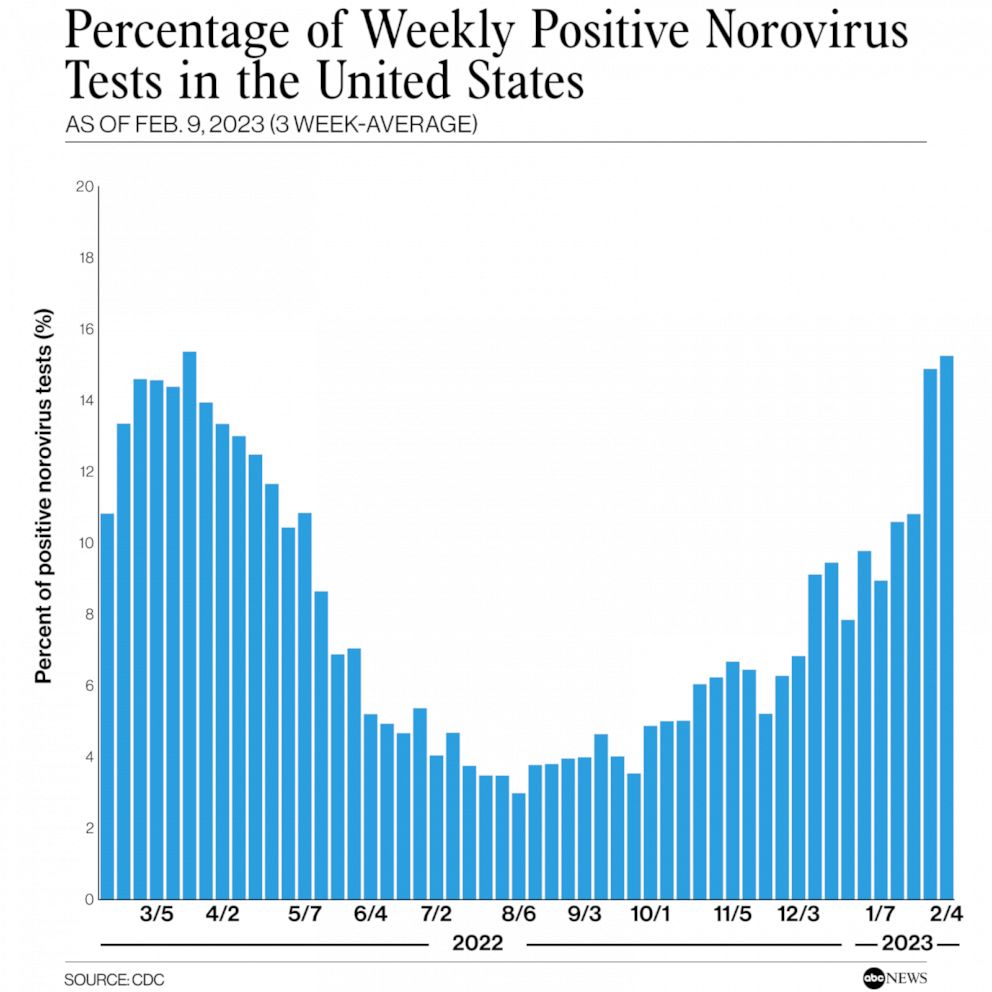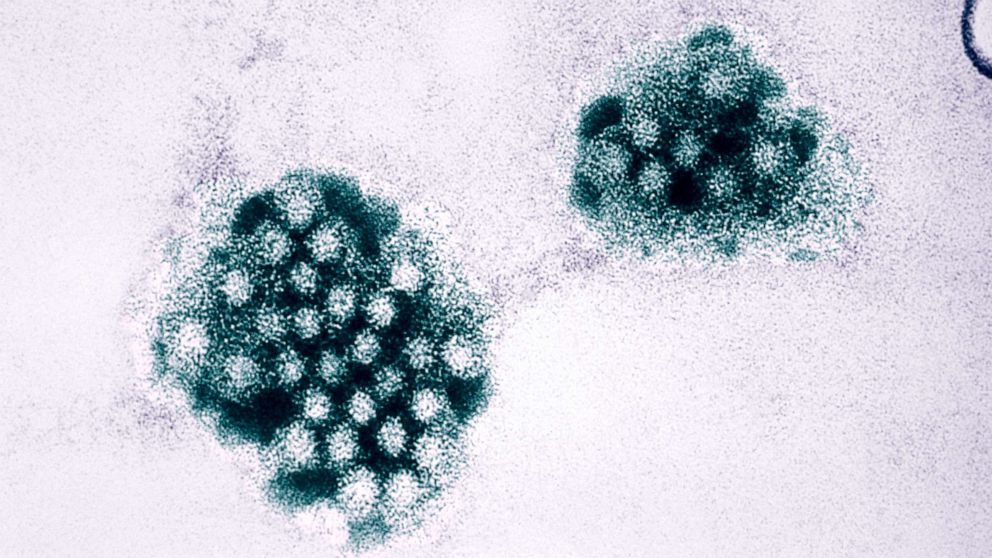What to know about the symptoms and treatment of norovirus as it spreads across the US - ABC News
Cases of norovirus are spreading across the United States and are higher than usual at this point in this season, according to data from the Centers for Disease Control and Prevention.
As of Feb. 9, more than 15% of weekly tests for norovirus are coming back positive, the highest seen since mid-March 2022. Additionally, 225 outbreaks have been recorded between Aug. 1, 2022 and Jan. 2, 2023, compared to 172 at this point last year, CDC data shows.
Norovirus has also been linked to outbreaks at two schools: an elementary school in Las Vegas and a preschool-grade 8 school in Livonia, Michigan -- 20 miles west of Detroit.
"It tends to occur in outbreaks, like it is not something that's kind of always there at a low level," Dr. Adam Ratner, director of pediatric infectious diseases at NYU Langone Hassenfeld Children's Hospital, told ABC News. "It's something where you see outbreaks in all sorts of different kinds of close communities -- a school daycare center -- we see norovirus outbreaks on cruise ships or in nursing homes."
Here's what you need to know about norovirus and how to best protect yourself from contracting it.
What is norovirus?
Norovirus is a highly contagious virus that is the most common cause of viral gastroenteritis, which is an inflammation of the inside lining of the gastrointestinal tract.
Although it's often referred to as the "stomach bug" or "stomach flu," norovirus illness is not related to influenza.

Percentage of Weekly Positive Norovirus Tests in the United States
CDC
In fact, it is the leading cause of foodborne illness in the United States, causing 58% of foodborne illnesses each year, according to the CDC.
The most common symptoms are nausea, vomiting, stomach pain and diarrhea. However, patients can also experience fever, headaches and body aches.
"They're probably a lot of people when they get infected that have very, very mild symptoms or no symptoms," Dr. John Segreti, a hospital epidemiologist at Rush University Medical Center in Chicago, told ABC News.
According to the federal health agency, every year the virus causes between 19 and 21 million illnesses, 109,000 hospitalizations and 900 deaths.
How is norovirus spread?
"One of the distinguishing features of norovirus is that it is highly contagious and transmissible, so just a few virus particles can cause someone to be sick," Dr. Soniya Gandhi, an infectious diseases specialist at Cedars-Sinai Medical Center in Los Angeles, told ABC News.
This means a person can become infected by having direct contact with someone who is infected and sharing food or utensils with them; touching surfaces or objects contaminated with norovirus and then touching your face or mouth; or consuming contaminated foods or liquids.
For the latter, this includes fruits and vegetables washed in contaminated water or shellfish, like oysters, harvested from contaminated water.
Typically, an infected person will develop symptoms between 12 to 48 hours after being infected. However, norovirus typically resolves quickly and, in most health adults it will only last one to three days, according to the CDC.
Is there a test for norovirus?
Dr. Karen Krueger, an assistant professor of medicine and infectious diseases at Northwestern University, told ABC News that often people don't even need to be tested for norovirus.
However, for those who are tested, it's not with a nasal swab or throat swab as is done with other viruses.

STOCK IMAGE/Getty Images
"We don't even necessarily test everybody who's affected since the symptoms are usually short lived, but in an outbreak setting, we really do want to be aware of what's going on and what strains are circulating out there to gain more information," she said. "So, in those situations, we generally perform the test by looking at genetic material norovirus in the stool, so it'd be the patient providing a stool sample."
How to treat norovirus
There is no specific treatment or antiviral for norovirus, so this means the treatment plan is managing symptoms.
Doctors say to make sure you're staying hydrated and to drink liquids that replenish electrolytes, which can be depleted through diarrhea and vomiting.
If you have a fever that causes discomfort, you can take anti-fever medication such as ibuprofen or acetaminophen.
Although symptoms will result in a few days for most people, certain groups are at high risk for severe dehydration including those under age 1, the elderly and the immunocompromised.
What to eat when you have norovirus
Similar to any illness that causes vomiting or diarrhea, doctors recommend eating bland food if you have norovirus such as bananas, dry toast, crackers and rice for about 24 to 48 hours.
Avoid eating foods or drinking liquids that might upset the stomach including spicy food, alcohol, caffeine and dairy products such as milk and cheese.
Segreti, however, said patients shouldn't force themselves to eat if they don't feel well.
"You shouldn't force yourself to eat," he said. "You should try to force yourself to drink fluids to maintain your hydration. And if you can't, seek medical help."
What is the difference between norovirus and food poisoning?
Norovirus is one form of food poisoning, the large umbrella term the describes being sick after eating or drinking.
Food poisoning can be caused by ingesting several types of germs including salmonella, campylobacter, E. coli and listeria.
Additionally, while norovirus symptoms can take up to 48 hours to appear, food poisoning symptoms typically occur between six and 12 hours later.
'The other piece with norovirus to recognize is that even after an individual recovers, and is feeling better, or they can shed norovirus in their stool for weeks subsequently," Gandhi said. "And so, I think that also contributes to its transmissibility and is a distinguishing feature from kind of the run-of-the-mill food poisoning."
Difference between norovirus, rotavirus and astrovirus
There's not much difference when it comes to norovirus, rotavirus and astrovirus.
Clinically, their symptoms are the same and you can't tell the difference between them unless you run a test.
However, rotavirus and astrovirus are more common in children and norovirus is more common in adults.
"The major difference among the three is that we now vaccinate against rotavirus," Ratner said. "So, rotavirus used to be super, super common, and it's much less common now in the U.S. because we routinely vaccinate children."
How to prevent norovirus
The experts say the best way to prevent getting norovirus is to wash your hands with warm soap and water for 20 seconds.
Norovirus has a lipid envelope -- a shell that protects it and helps it evade recognition by the immune system -- making alcohol-based sanitizers less protective.
"Norovirus actually has a pretty tough protective shell," said Gandhi. "So, alcohol doesn't deactivate the virus as well and is not as effective as handwashing, eliminating norovirus from your hands. So that is the number one tool we have."

In this undated file photo, an electron micrograph of the norovirus is shown.
UIG via Getty Images, FILE
The CDC says to makes sure you're washing your hands after you use the toilet or change diapers as well as when you're eating, preparing or handling food.
To prevent contamination from food, make sure fruits and vegetables are washed and that shellfish is cooked to at least an internal temperature of 145F.
Lastly, clean and disinfect food preparation surfaces and any area where someone vomited or had diarrhea.
"And then for individuals who do get sick, it's really important to isolate yourself until you've been feeling better for 48 hours," Krueger said.
Comments
Post a Comment